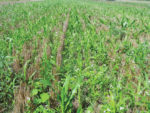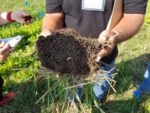Advertise Follow Us
Items Tagged with 'crop rotation'
ARTICLES
Comparing Profitability of Regenerative Ag, No-Till & Tillage
Adding No-Till Wheat to Rotation Improves Soil Health, Field Conditions
Take a Systems Approach to No-Till to Improve Soil Health
PRODUCTS
How Aboveground Rotations Affect Belowground Processes in No-Till - Lisa Tiemann - NNTC 2016 Presentation - MP3 Download
Increasing plant biodiversity has been experimentally linked to increases in productivity, nutrient availability, ecosystem stability and resource-use efficiency, but the consequences of crop rotational diversity on belowground processes is uncertain. Lisa Tiemann is working to provide insights into belowground responses to rotational diversity. The Michigan State University soil biologist presents a combination of analytical and experimental data to help reveal rotational diversity effects on belowground processes that lead to enhanced soil services in agro-ecosystems.
ViewBeating Weeds, Diseases and Insects with Diverse No-Till Rotations - Dwayne Beck - NNTC 2016 Presentation - MP3 Download
Weeds, diseases and insects are nature’s way of adding diversity to a system that lacks it. You can try to find technologies that can control all the problems that pop up, or you can prevent most of them by providing beneficial diversity of your own. Dwayne Beck explains why no-tillers will want to rediscover rotational techniques for managing pests, especially with current cost/price ratios. The director of the Dakota Lakes Research Farm near Pierre, S.D., shares why crop rotations that are consistent in sequence or interval provide opportunity for weeds and insects. He also discusses the strengths and weaknesses of different types of rotation.
ViewThe Need for Transformation in Your No-Till System - Dwayne Beck - NNTC 2016 Presentation - MP3 Download
Almost all change in agriculture is and has been incremental. For the most part, no-till systems differ little from conventional systems. If we’re going to solve the environmental issues and energy issues we face, we must take a different approach. Dwayne Beck discusses how we can do things differently to solve these problems, specifically with crop rotation. The director of the Dakota Lakes Research Farm in Pierre, S.D., shares how crop rotation is more complex than simply adding wheat or cover crops. He talks about how to look at your system and find the things that let you avoid many of the problems that are now costing you lots of money and a loss of productivity.
ViewCover Crop Know-How From 30 Years — What’s Coming In The Next 30 Years - Steve Groff - NNTC 2015 Presentation - MP3 Download
Steve Groff has more than 30 years experience covering fields on his no-till farm in southern Pennsylvania. He’ll share his best tips for making cover crops more practical on your farm, including ways to get them planted in a timely manner, how they interact with nutrients in your soils, rotational decisions and other key discoveries through proven, field-tested practices and onfarm research.
ViewMirroring Mother Nature To Build A Highly Functioning No-Till System - Bryan Jorgensen - NNTC 2015 Presentation - MP3 Download
With 18,000 total acres, including 11,000 cropping acres and 7,000 acres of native pasture, Jorgensen Land & Cattle have utilized no-till to efficiently raise crops. But they don’t necessarily take a simple approach. Instead, Bryan Jorgensen says they rely on a diverse rotation of up to 12 crops to create a system as productive as Mother Nature.
View













